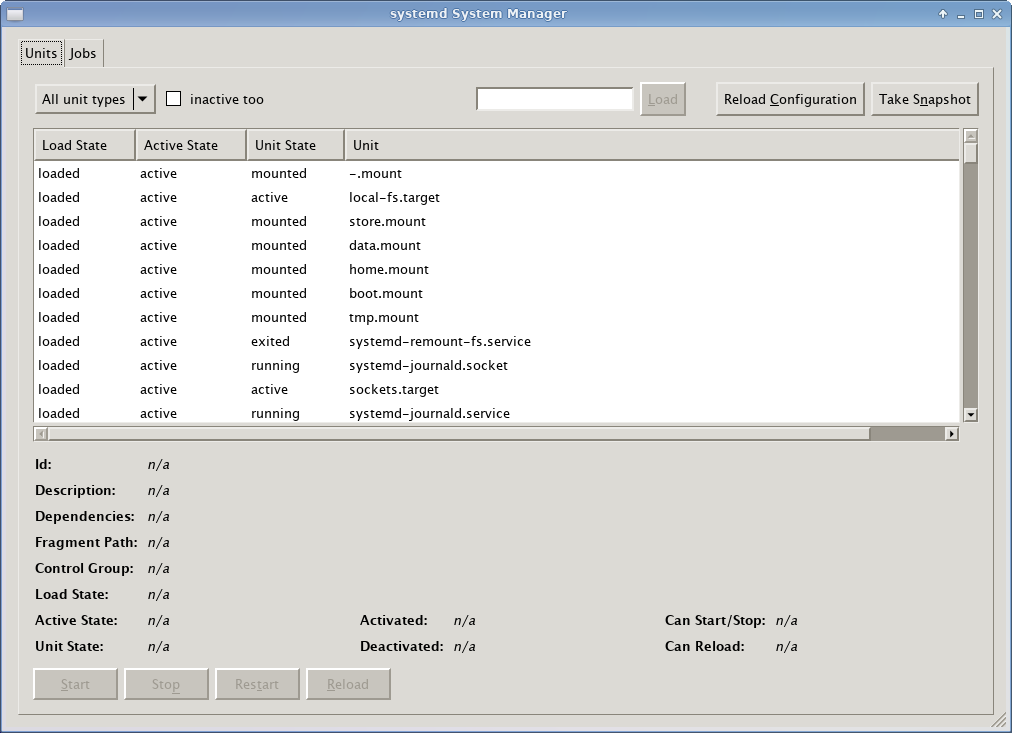systemd is a system and service manager for Linux. It is a replacement for sysvinit. It provides an improved way of booting up the system (allowing more work to be done in parallel at system startup) and also to manage services. “systemd” appears a remarkable adoption from many Linux distributions. Some of them are Fedora, Mandriva, openSUSE, ArchLinux. In Debian and Gentoo systemd is available, but not enabled by default. Inclusion in Red Hat Enterprise Linux 7 is also planned.
In short, except Ubuntu who has developed its own startup manager, almost all the rest distributions will use systemd as system and service manager.
Archlinux included systemd since October 2012. From now, initscripts will be dropped from various packages. Any users still using them should switch to systemd.
This is just a practical guide for migration to systemd in Archlinux. In order to be useful, you have to read carefully the basics about systemd at:
- Freedesktop systemd homepage
- Archlinux wiki page about systemd
- systemd project page (by Lennart Poettering, systemd creator)
- Why systemd (by Lennart Poettering, systemd creator)
- Wikipedia article about systemd
systemd setup
First make a copy of your rc.conf
sudo cp /etc/rc.conf /data/tmp/rc.conf.bak
systemd must be installed during a system upgrade. Partial upgrades are unsupported in Archlinux.
Full system update:
sudo pacman -Syu
Then remove sysvinit and install systemd-sysvcompat
sudo pacman -Rns sysvinit initscripts
sudo pacman -S systemd-sysvcompat
systemd should have been installed during system upgrade, otherwise last command should be:
sudo pacman -S systemd systemd-sysvcompat
Configuration files needed by systemd
systemd needs some configuration files to hold information, which /etc/rc.conf kept until now to your system:
As root:
nano /etc/hostname
Add a line with your hostname, in my case:
athena
nano /etc/timezone
Add a line with your timezone, in my case:
Europe/Athens
nano /etc/vconsole.conf
Add appropriate values, in my case:
FONT_MAP=
KEYMAP=us
FONT=
nano /etc/locale.conf
Add appropriate values, in my case:
LANG=en_US.UTF-8
Add modules definitions in /etc/modules-load.d/, in my case:
nano /etc/modules-load.d/nfsd.conf
nfsd
nano /etc/modules-load.d/vboxdrv.conf
vboxdrv
nano /etc/modules-load.d/vboxnetadp.conf
vboxnetadp
nano /etc/modules-load.d/vboxnetflt.conf
vboxnetflt
There is a helper tool which can perform the above task for you. Find it on Github: arch-linux-SysV-to-systemd-migrationscript. This script will parse your /etc/rc.conf and generate the above config files.
Create service files
At this time, only a part of information existed in /etc/rc.conf has been migrated using the “systemd” way. Another task is to tranform DAEMONS array members to systemd services. In my case DEAMONS array was:
DAEMONS=(syslog-ng network crond sshd !hwclock ntpd apcupsd rpcbind nfs-common alsa dbus samba cupsd webmin exim httpd mysqld)
For each DEAMONS element you have to create a service file at /etc/systemd/system/ folder. Fortunately, these files exist at /usr/lib/systemd/system/
For example to start Apache at boot, give:
systemctl enable httpd.service
Archlinux will create the appropriate symbolic links. Example:
ls -la /etc/systemd/system/multi-user.target.wants/
Result:
drwxr-xr-x 2 root root 4096 Apr 4 22:50 .
drwxr-xr-x 6 root root 4096 Apr 4 18:26 ..
lrwxrwxrwx 1 root root 39 Apr 4 14:50 apcupsd.service -> /usr/lib/systemd/system/apcupsd.service
lrwxrwxrwx 1 root root 44 Apr 4 15:12 avahi-daemon.service -> /usr/lib/systemd/system/avahi-daemon.service
lrwxrwxrwx 1 root root 46 Apr 4 15:13 avahi-dnsconfd.service -> /usr/lib/systemd/system/avahi-dnsconfd.service
lrwxrwxrwx 1 root root 33 Apr 4 18:26 cups.path -> /usr/lib/systemd/system/cups.path
lrwxrwxrwx 1 root root 36 Apr 4 14:55 exim.service -> /usr/lib/systemd/system/exim.service
lrwxrwxrwx 1 root root 37 Apr 4 14:37 httpd.service -> /usr/lib/systemd/system/httpd.service
lrwxrwxrwx 1 root root 38 Apr 4 14:55 mysqld.service -> /usr/lib/systemd/system/mysqld.service
lrwxrwxrwx 1 root root 35 Apr 4 22:50 network.service -> /etc/systemd/system/network.service
lrwxrwxrwx 1 root root 36 Apr 4 14:53 nfsd.service -> /usr/lib/systemd/system/nfsd.service
lrwxrwxrwx 1 root root 36 Apr 4 15:10 ntpd.service -> /usr/lib/systemd/system/ntpd.service
lrwxrwxrwx 1 root root 40 Mar 22 14:34 remote-fs.target -> /usr/lib/systemd/system/remote-fs.target
lrwxrwxrwx 1 root root 39 Apr 4 14:53 rpcbind.service -> /usr/lib/systemd/system/rpcbind.service
lrwxrwxrwx 1 root root 36 Apr 4 14:53 sshd.service -> /usr/lib/systemd/system/sshd.service
lrwxrwxrwx 1 root root 41 Apr 4 14:54 syslog-ng.service -> /usr/lib/systemd/system/syslog-ng.service
lrwxrwxrwx 1 root root 38 Apr 4 14:54 webmin.service -> /usr/lib/systemd/system/webmin.service
Static IP Ethernet network
systemd network.service must be created manually. An example is provided in ArchWiki here: Static Ethernet network
sudo nano /etc/conf.d/network
interface=eth0
address=192.168.1.51
netmask=24
broadcast=192.168.1.255
gateway=192.168.1.1
sudo nano /etc/systemd/system/network.service
[Unit]
Description=Network Static IP
Wants=network.target
Before=network.target
BindsTo=sys-subsystem-net-devices-eth0.device
After=sys-subsystem-net-devices-eth0.device
[Service]
Type=oneshot
RemainAfterExit=yes
EnvironmentFile=/etc/conf.d/network
ExecStart=/sbin/ip link set dev eth0 up
ExecStart=/sbin/ip addr add 192.168.1.51/24 dev eth0
ExecStart=/sbin/ip route add default via 192.168.1.1
ExecStop=/sbin/ip addr flush dev eth0
ExecStop=/sbin/ip link set dev eth0 down
[Install]
WantedBy=multi-user.target
Reboot
Reboot your system. If everything has gone well, you will notice a faster system startup.
systemd basic commands
With UNIT we mean the unit/service name (for example: mysqld.service)
- Enable (run on startup):
systemctl enable UNIT
- Disable:
systemctl disable UNIT
- Get UNIT status:
systemctl status UNIT
- List units/services:
systemctl list-unit-files
- Start manually:
systemctl start UNIT
- Stop manually:
systemctl stop UNIT
- Restart manually:
systemctl restart UNIT
- Reload UNIT configuration:
systemctl reaload UNIT
- Analyse boot process:
systemd-analyze
example:
Startup finished in 4496ms (kernel) + 19558ms (userspace) = 24054ms
- Analyse boot process (details):
systemd-analyze blame | less
- Analyse boot process (graph):
systemd-analyze plot > /path/to/result.svg
- Reboot:
systemctl reboot
- Halt:
systemctl halt
- Poweroff:
systemctl poweroff
Open in new tab image below to see (in details) systemd-analyze plot in my system as SVG file:
systemadm: systemd System Manager graphic GUI
systemadm is the official graphical frontend for
systemctl. You may install it from AUR using:
yaourt systemd-ui-git

Well, it seems that systemd will become the default init and service manager for the most Linux distributions. What do you think? Leave us a comment.
Entrepreneur | Full-stack developer | Founder of MediSign Ltd. I have over 15 years of professional experience designing and developing web applications. I am also very experienced in managing (web) projects.
